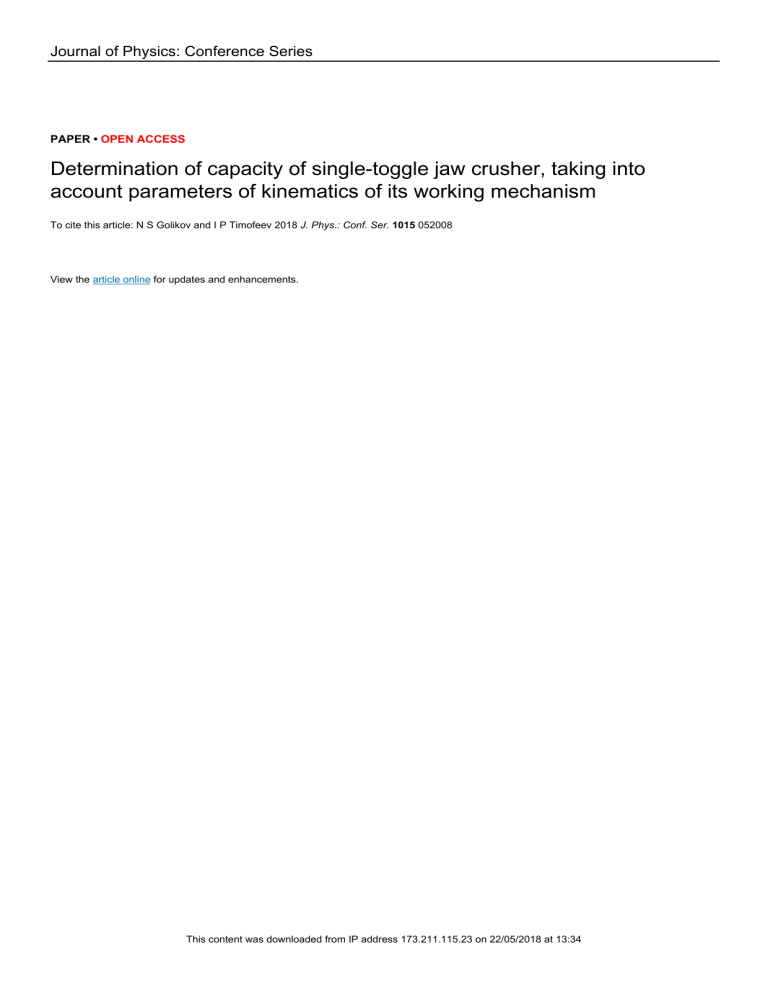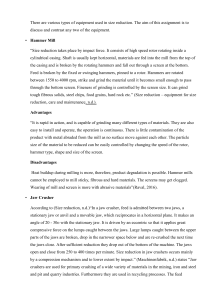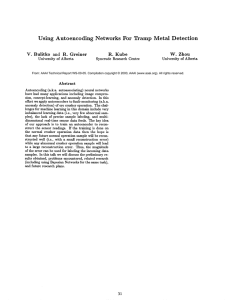
Journal of Physics: Conference Series PAPER • OPEN ACCESS Determination of capacity of single-toggle jaw crusher, taking into account parameters of kinematics of its working mechanism To cite this article: N S Golikov and I P Timofeev 2018 J. Phys.: Conf. Ser. 1015 052008 View the article online for updates and enhancements. This content was downloaded from IP address 173.211.115.23 on 22/05/2018 at 13:34 International Conference Information Technologies in Business and Industry 2018 IOP Publishing IOP Conf. Series: Journal of Physics: Conf. Series 1015 (2018) 1234567890 ‘’“” 052008 doi:10.1088/1742-6596/1015/5/052008 Determination of capacity of single-toggle jaw crusher, taking into account parameters of kinematics of its working mechanism N S Golikov, I P Timofeev Saint-Petersburg Mining University, 2, 21st Line, St Petersburg, 199106, Russia E-mail: Golikov_NS@pers.spmi.ru Abstract. Efficiency increase of jaw crushers makes the foundation of rational kinematics and stiffening of the elements of the machine possible. Foundation of rational kinematics includes establishment of connection between operation mode parameters of the crusher and its technical characteristics. The main purpose of this research is just to establish such a connection. Therefore this article shows analytical procedure of getting connection between operation mode parameters of the crusher and its capacity. Theoretical, empirical and semiempirical methods of capacity determination of a single-toggle jaw crusher are given, taking into account physico-mechanical properties of crushed material and kinematics of the working mechanism. When developing a mathematical model, the method of closed vector polygons by V. A. Zinoviev was used. The expressions obtained in the article give an opportunity to solve important scientific and technical problems, connected with finding the rational kinematics of the jaw crusher mechanism, carrying out a comparative assessment of different crushers and giving the recommendations about updating the available jaw crushers. 1. Introduction One of the main directions of development of mining industry, along with the selective cutting [4], complex use of mineral resources [10] and improvement of dressing processes, is the intensification of production through increased productivity of equipment and plants. The first stage of processing of solid minerals – ore preparation, – begins with crushing bulk materials and sorting them by size. Single-toggle jaw crushers are used at the beginning of this process [7] and are among the main machines for crushing. Jaw crushers are widely used in many different industries to crush brittle materials with various strength. Usually, jaw crushers are put at the beginning of the technological lines of ore-dressing and sample cutting. About three milliard tons of mineral and other materials are crushed every year by these machines. It is necessary to mention that crushing operations are characterized by high capital and operating costs. Capacity is an important technological characteristic of crushers, which determines their effectiveness and characterizes the conditions for the passage of material through the working chamber. Content from this work may be used under the terms of the Creative Commons Attribution 3.0 licence. Any further distribution of this work must maintain attribution to the author(s) and the title of the work, journal citation and DOI. Published under licence by IOP Publishing Ltd 1 International Conference Information Technologies in Business and Industry 2018 IOP Publishing IOP Conf. Series: Journal of Physics: Conf. Series 1015 (2018) 1234567890 ‘’“” 052008 doi:10.1088/1742-6596/1015/5/052008 2. Factors affecting jaw crusher capacity The mathematical model of the working process of the crusher should take into account many factors. Operating experience and investigations have shown that the performance of jaw crushers significantly depends on their design and the motion law of its function element – the moving jaw [5], [6]. Design parameters of the single-toggle jaw crusher are: length L and width B of the charging opening, the shape of the longitudinal and transverse profile of the crushing plates [1]. The parameters that determine the motion law of the moving jaw are the parameters of the kinematic scheme of the working mechanism (Figure 1): the eccentricity of the main shaft is l1, m; length of the moving jaw is l2, m; the length of the toggle plate is l3, m; thickness of the moving jaw is h, m; the working chamber depth is H, m; the position angle of the toggle plate is γ, deg; the inclination angle of the working surface of the moving jaw is Ψ, deg; the nip angle of the working chamber is α, deg; rotation speed of the main shaft is n, rev/min. The capacity is also influenced by physico-mechanical properties of the original material: grain size, limit of the compressive strength [15] and specific gravity. Capacity depends on some random factors: a type of delivery and a method of loading of initial material, uniformity of charging and distribution along the length of the charging opening, a filling degree of the working chamber, a probability of pieces capture by function elements (stationary and moving jaw) and others. However, largely, the capacity of the crusher is determined by working mechanism kinematics. O1 B l1 F D n A H α h l2 Ψ γ O3 C E l3 B Figure 1. Kinematical scheme and kinematic parameters of single-toggle jaw crusher 3. Capacity determination methods To date, many theoretical, empirical and semi-empirical dependencies for approximate evaluation of a single-toggle jaw crusher capacity have been proposed. The generalization of these dependencies is proposed in [17]. Detailed comments can be found in [2], [12] and [15]. One of the most famous empirical formulas is based on the fact that the performance of a single-toggle jaw crusher is directly proportional to the area of the charging opening described by F. Taggart in 1927 [16]: Q = 930 ⋅ L ⋅ B , where L and B are the length and the width of the jaw crusher charging opening, m. Taggart formula takes into account just two structural settings of the crusher. However, it is quite fair for crushers of medium size but not very big and not very small. From the theoretical formulas of capacity calculation the formula of T. Simons became widely implemented, and in Russian technical literature was transformed and reduced by L. B. Levenson in 1933 [11]. It is based on theoretical determination of the volume of material falling from the working chamber under the action of gravity during the withdrawal of the moving jaw. It is assumed that the 2 International Conference Information Technologies in Business and Industry 2018 IOP Publishing IOP Conf. Series: Journal of Physics: Conf. Series 1015 (2018) 1234567890 ‘’“” 052008 doi:10.1088/1742-6596/1015/5/052008 part of the working chamber called “fallout prism” which is below certain level h will be discharged. At this level, the width of the working chamber should match the width of discharge gap b at the moment of its maximum disclosure (Figure 2): s , h= tgα where s is the compression stroke of the moving jaw in the lower part of the working chamber, mm; α – nip angle of the crusher, deg. B S S D F α b y s C E x bmin bmax s x Dmin O x Dmax xCmin xCmax xE , xF Figure 2. Fallout prism of the Figure 3. Design model for determining the input B and output b jaw crusher working chamber gap width and the compression stroke of the moving jaw at the input S and output s level of the working chamber The area of the longitudinal section of the working chamber is located below the level of h: 1 F = ⋅ b min + b max ⋅ h , 2 where bmin and bmax - the minimum and maximum width of discharge gap, mm. Then the volume of the fallout prism is: V = F⋅L. The mass of material is enclosed in a given volume, taking into account voids between the pieces of material: m =V ⋅γ ⋅ µ , where γ is the density of the processed material; µ – coefficient of loosening of the material in the working chamber. In this case, the performance of the crusher will be determined as the product of the mass of material emerging from the working chamber during the withdrawal of the moving jaw by the number of revolutions of the main shaft: Q =m⋅n. Thus, the theoretical capacity of the crusher will be determined by the formula of Levenson by the expression: ( ) 3 International Conference Information Technologies in Business and Industry 2018 IOP Publishing IOP Conf. Series: Journal of Physics: Conf. Series 1015 (2018) 1234567890 ‘’“” 052008 doi:10.1088/1742-6596/1015/5/052008 ( ) 30 ⋅ b min + b max ⋅ s ⋅ L ⋅ n ⋅ µ ⋅γ . tgα This formula contains several parameters related to the kinematical scheme of the crusher, as it is based on the determination of the volume of the working chamber fallout prism at the unloading zone. Similarly, let us take into account works of other well-known experts: Dombrowski, Kontorovich, Anokhin, Pikovsky and Saginova. However, this formula did not take into account the influence of the physical properties of the crushed material, as it was determined by the geometry of the working mechanism. The possibility of application of this formula is limited, because modern crushers do not have a strictly rectilinear, but curvilinear profile of the bottom of the working chamber. The material in the working chamber is loosened. In the formula of capacity, it is considered by an appropriate factor. In his work L. B. Levenson proposes adopting µ=0.4÷0.7. In the recent works of B. V. Klushantsev, it is recommended to take µ=0.5÷0.6. The smaller the degree of fragmentation is, the stronger and larger the crushed material is, the less value of µ one should choose. The larger the value of µ is, the more effective the kinematics and the design of the crusher are. However, for µ there is an upper limit due to the fact that the total volume of the destroyed piece is always greater than the volume of this piece in the monolith. Therefore, the crushing process can proceed effectively only if the material in the crushing chamber will be in a slightly loosened condition; otherwise it may cause the phenomenon of pressing and then crushing stop. Thus, the value of µ=0.8÷0.9 should be considered to be the limit, to ensure the normal operation of the crushing machine. In 1967, B. V. Klushantsev conducted the experiments [8] showing that the jaw crusher capacity is directly proportional to the volume of the working chamber and the oscillation frequency of the function element (moving jaw), and it is inversely proportional to the crushing ratio: Q= Q= 30 ⋅ (B − b ) ⋅ S av ⋅ L ⋅ n ⋅ µ ⋅γ , i ⋅ tgδ where B and b – width of the input and discharge gaps, m; Sav – average compression stroke of the moving jaw, m; i – crushing ratio. The calculation results using this semi-empirical formula are well correlated to the actual ones. Therefore today this formula is often found in handbooks and manuals devoted to development of the processing machines. 4. Mathematical modelling The analysis of the dependencies, given higher and dependencies proposed in recent times, shows that none of them takes into account fully all the necessary kinematic parameters of a single-toggle jaw crusher. The lack of functional relationships between the kinematic parameters of the jaw crusher working mechanism and its capacity makes it impossible to carry out the optimization of the crusher kinematical scheme, or to choose rational values of kinematic parameters based on specific industrial tasks. Therefore, as it was noted at the beginning of this article, the establishment of such relationships can be considered a relevant and promising task at present. Because of all the existing capacity formulas, only the formula of B. V. Klushantsev meets most fully the requirements of the assigned task, it may be used as a basis for new analytical dependences. Geometrical parameters of the crusher kinematical scheme included in this formula can be expressed through the parameters of the trajectories of the moving jaw points [5], [14]. Width of the input and output gap of the crusher is the distance between the jaws at the moment of their greatest distance from each other, measured at the top and bottom of the working chamber (Figure 3): B = x F − x Dmin and b = x E − xCmin . The crushing ratio can be defined constructively as the ratio of the width of the input gap to the width of the output gap (discharge gap): i = B b. 4 International Conference Information Technologies in Business and Industry 2018 IOP Publishing IOP Conf. Series: Journal of Physics: Conf. Series 1015 (2018) 1234567890 ‘’“” 052008 doi:10.1088/1742-6596/1015/5/052008 The average compression stroke in accordance with the expression proposed by B. V. Klushantsev [8] is the arithmetical mean of the compression strokes at the top and bottom of the working chamber: S ср = (S + s ) 2 . The compression stroke at the input S and output s level of the working chamber is estimated by the projections of the trajectories of the points of the moving jaw on an axis perpendicular to the stationary jaw (Figure 3), and can be defined as the difference between the abscissa of corresponding points: S = x Dmax − x Dmin and s = xCmax − xCmin . After substitution, the formula of capacity by B. V. Klushantsev will look like: x min − x Dmin ⋅ xCmax + x Dmax − xCmin − x Dmin Q = 15 ⋅ xCmin ⋅ C ⋅ L ⋅ n ⋅ µ ⋅γ м . x Dmin tgδ The values of the abscissa points are determined analytically: j j x j = O1 A ⋅ cos 180° − ϕ Oj1 A + AD ⋅ cos 180° − ϕ AD + l ⋅ cos 180° − ϕ DC , ( )( ( ) ) ( ) ( ) where O1A and AD – edge lengths of links of the jaw crusher kinematical scheme; l – coordinate of the studied point of the working surface of the moving jaw; φO1A, φAD, φDC = f (l1, l2, l3, h, h, γ, ψ, δ) is the angular coordinates of the edges of links in the j-th position of the mechanism (Figure 4), deg. The coordinates of the upper point of the working surface of the moving jaw can be obtained by l=0 and the bottom - by l=DC. The angles of edges AD and CD of the connecting rod, deg: ϕ AD = ϕ 2 − ψ 1 , ϕ DC = ϕ AD − ψ 2 + 180° . The angle of inclination of connecting rod φ2 in the function of the generalized coordinates of the mechanism can be determined by standard analytical methods of the theory of mechanisms and machines [3] and [15], used for kinematic analysis of the jointed four-bar linkage. Particularly, let us use the most simple of them - the method of closed vector polygons devised by V. A. Zinoviev. ϕ1 y O1 B x ϕ2 A l2 y ϕ3 l3 A D l1 O1 Figure 4. The angle of inclination of the connecting rod l4 O3 x Figure 5. Closed vector polygons built for a crank mechanism To do this, let us transform the links of the closed kinematic chain of the operating mechanism of the crusher to a closed polygon of vectors, whose sum is zero (Figure 5). The vector equation for this case will look like: l1 + l2 + l3 + l4 = 0 . Let us assign a coordinate system whose center coincides with the center of joint O1, and axis Ox coincides with the line of the strut and is directed towards the center of joint O3. Then project the vector equation on the axis of the obtained coordinate system: 5 International Conference Information Technologies in Business and Industry 2018 IOP Publishing IOP Conf. Series: Journal of Physics: Conf. Series 1015 (2018) 1234567890 ‘’“” 052008 doi:10.1088/1742-6596/1015/5/052008 l1 ⋅ cos ϕ1 + l2 ⋅ cos ϕ 2 + l3 ⋅ cos ϕ 3 + l4 ⋅ cos ϕ 4 = 0 . l1 ⋅ sin ϕ1 + l2 ⋅ sin ϕ 2 + l3 ⋅ sin ϕ 3 + l4 ⋅ sin ϕ 4 = 0 Taking into account that φ4=0, one can write: cosφ4=1º and sinφ4=0º. Then the system of equations can be converted as follows: l1 ⋅ cos ϕ1 + l2 ⋅ cos ϕ 2 + l3 ⋅ cos ϕ 3 + l4 = 0 . l1 ⋅ sin ϕ1 + l2 ⋅ sin ϕ 2 + l3 ⋅ sin ϕ 3 = 0 Let us denote the known values as: q = l1 cos ϕ1 + l4 . u = l1 ⋅ sin ϕ1 Then the system of equations becomes: l2 ⋅ cos ϕ 2 + l3 ⋅ cos ϕ 3 = − q . l2 ⋅ sin ϕ 2 + l3 ⋅ sin ϕ 3 = −u In order for the equations to have the only one unknown parameter (in this case, required variable angle φ2), let us transfer the first term of the left parts of each equation of the system to the right-hand sides, so that only one term containing φ3 remained in the left part: l3 ⋅ cos ϕ 3 = − q − l2 ⋅ cos ϕ 2 . l3 ⋅ sin ϕ 3 = −u − l2 ⋅ sin ϕ 2 Let us bring both parts of both equations of the system into a square, fold the relevant parts of these equations, and perform some transformations: l32 − q 2 − u 2 − l22 u = cos ϕ 2 + ⋅ sin ϕ 2 . 2 ⋅ q ⋅ l2 q Let us introduce the following symbols: l32 − q 2 − u 2 − l22 u = tgν . = a and q 2 ⋅ q ⋅ l2 Then the equation gets the form: a = cos ϕ 2 + tgν ⋅ sin ϕ 2 . Multiplying both parts of the equation by cosv will give us: a ⋅ cosν = cos(ϕ 2 − ν ) . From this equation, let us obtain an expression for the angle position of the connecting rod in functions of the generalized coordinates of the mechanism: ϕ 2 = acr cos(a ⋅ cosν ) + ν . This expression allows oneto analytically determine the coordinates of the working surface points of the moving jaw (see above), and calculate the capacity of the single-toggle jaw crusher at the stage of its designing. 5. Conclusion Mathematical modeling of the working process of the jaw crusher and establishing functional relationships between the geometrical parameters of the kinematical scheme of the working mechanism and capacity of the single-toggle jaw crusher became possible because of two factors. First, the description of the technological parameters of the jaw crusher included in the formula of its capacity using the parameters of the working surface point’s trajectories of the moving jaw. Second, the coordinates of these points were derived using the analytical method of the theory of mechanisms and machines proposed by V. A. Zinoviev. The obtained expressions give an opportunity to solve an important scientific and technical problem of choosing rational values of the parameters of the kinematical scheme of the crusher. The developed mathematical model allows one: 6 International Conference Information Technologies in Business and Industry 2018 IOP Publishing IOP Conf. Series: Journal of Physics: Conf. Series 1015 (2018) 1234567890 ‘’“” 052008 doi:10.1088/1742-6596/1015/5/052008 1. to appreciate how operation mode parameters effect the technical characteristics of the crusher; 2. to find the rational kinematics of the jaw crusher mechanism (for example when developing a new model of a single toggle jaw crusher); 3. to carry out a comparative assessment of the available crushers of the described type; 4. to give the recommendations about updating the available crushers. References [1] Aybashev D M, Kolga A D, Hazhiev A A 2014 Influence of grooved crushing plates of jaw crushers on the efficiency of crushing process Bulletin of development of science and education 3 163-166 [2] Denegin V V 1993 To the question of the capacity of the jaw crusher Journal of Mining Institute 138 29-31 [3] Eremenko A I 2010 Analytical kinematics and dynamics of mechanisms (Kiev: NUBIP) [4] Gabov V V, Zadkov D A 2016 Energy-saving modular units for selective coal cutting Eurasian mining 1 37-40 [5] Golikov N S 2011 The mathematical model of the single-toggle jaw crusher Materials of the conference: TulGU 1 164-169 [6] Golikov N S 2010 Substantiation of rational kinematics of a single-toggle jaw crusher (SaintPetersburg: Saint-Petersburg Mining University) [7] Iamov A V, Kuznetsov I A, Babyk A V, Rubis S A 2014 Assesment of costs associated with the introduction of technology coarse crushing on the example of the diamond deposit them M.V.Lomonosov Journal of Mining Institute 208 203-207 [8] Klushantsev B V 1967 Research of jaw crusher with different kinematics with the aim of improving their technical and operational indicators (Moscow: MISI) [9] Konishchev V O 2013 Mechanic. Theory of mechanisms and machines (Krasnoyarsk: Siberian Federal University) [10] Kuskov V B, Kuskova Ya V 2013 Complex use of iron ores in iron and steel industry Journal of Mining Institute 202 111-114 [11] Levenson L B 1933 Machines for mineral dressing, their theory, calculation and design (Moscow-Leningrad: GosMashMetIzdat) [12] Muizemnek Y A 1998 Capacity of the double-toggle jaw crusher News of the Higher Institutions. Mining Journal (Ekaterinburg: The Ural State Mining University) v 5-6 [13] Muizemnek Y A, Zimin A I, Muizemnek A Y, Zimin I A 2000 Capacity calculation of large jaw and cone crushers of the Higher Institutions. Mining Journal 4 [14] Potemkin S A 2000 Improving the methods of calculation and substantiation of rational parameters of single-toggle jaw crushers (Moscow: MosGUGiK) [15] Rodin R A, Logic L I, Zapadinsky L K 1984 Method for capacity adjustment of jaw crushers depending on the properties of the crushed material Proceedings of VNIIStroydormash 99 [16] Taggart A F 1998 Handbook of ore dressing (John Willey & Sons Inc) [17] Zimin A I, Govorov A V, Kanusik Y P 1998 Consumption and optimization of operation mode parameters of the jaw crushers News of the Higher Institutions. Mining Journal 5-6 7



